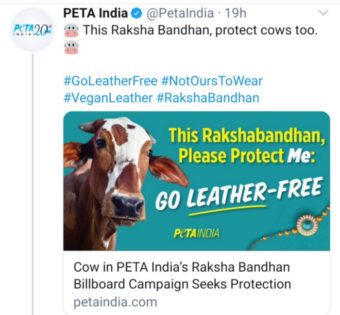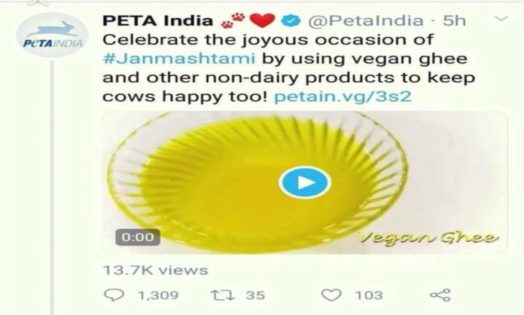Demonizing Hindu Festivals in the Name of Animal Activism

Why Hindu festivals are soft targets?
As a child, there was always excitement when festivals were around. Grown-ups and kids were equally excited. There was always excitement in the air with new dresses, gifts adding to the happiness. A sense of belonging prevailed. This was the connection that we all felt with each other in the family, in the neighborhood during every festival.
But today the same buzz cannot be seen. Why? Whenever there is a Hindu festival around, all sorts of activism are on active mode, especially the animal activists. The media, ads, international media, TV – many a platform in the chorus runs propaganda against Hindu festivals.
There was a time when newspapers, ads were filled with cultural vibrancy of our festivals but today it is not so. Earlier, kids in schools were asked to write the importance of our festivals but today they are taught how Hindu festivals are not in harmony with nature.
Let us discuss a few incidents of how our festivals are targeted.
1. Cow in PETA India’s Raksha Bandhan Billboard Campaign Seeks Protection–

Recently PETA India, one of the world’s largest animal rights organizations, placed bill boards across the country on the occasion of Raksha Bandhan. Their official portal that carried the news opens with the following paragraph:
As Raksha Bandhan approaches, PETA India has placed billboards in Ahmedabad, Bhopal, Chandigarh, Jaipur, Kanpur, and Patna featuring a cow proclaiming, “Protect Me – Go Leather-Free.” Cows are our sisters under the skin, and like us, are made of blood, flesh and bone and want to live. And so, the festival provides a great opportunity to celebrate our cow sisters by including them in our circle of protection, by pledging to go leather-free for life.
What is the connection of Raksha Bandhan with cow protection? Hindus never use leather or animal products during worship. Generally, rakhis are offered to the deity at the home before the ceremony begins. When rakhis are tied, the deities are invoked first. Hence there is no question of leather rakhis being used. Frankly speaking I personally never have seen rakhis around the market with leather straps, or in short, a leather rakhi.
PETA should talk with proper facts and figures before targeting Hindu festivals.
If PETA’s activism is a genuine one why don’t they take on the giants like Vero Moda, Armani, Gucci, etc. Why don’t they take on the beef industry? Why not target organizations and people running the beef business?
2. PETA’s activism tested– A hoarding by PETA was removed after a complaint by President of the Islamic Centre of India as it hurt their religious sentiments.

And this was the exact statement he made “The hoarding is sending out a wrong message, it is objectionable. The community strongly objects to it.”
No one challenged them on social media like twitter, FB, or via newspapers? Nor did PETA India try to challenge them. As they clearly knew the repercussions of doing so!
2. Celebrate Janamashtami using vegan ghee to keep cows happy too– This was two years back when PETA again tried to push on their activism through Janmashtami. Ghee is an integral part of Lord Krishna’s life. To quote DNA India, “After all, If you look at paintings and listen to your grandmother’s tales, then there is always an association of Lord Krishna with ghee or as the rest of the world knows it.”

Why activism by the media and NGOs goes on sleep mode when it is actually required?
During the Bakr-Eid, streets and roads turning red with the blood of goats, sheep, cows, and camels on the day of the festival have upset compassionate citizens.
To quote PETA, ‘About 240 million turkeys are raised for food every year in the U.S.; approximately 85 million of them are slaughtered and eaten for Thanksgiving, Christmas, and Easter.’
What impression can be left on upcoming generations by such propaganda?
1. It is but obvious someone growing up in a toxic environment filled with anti-Hindu sentiments will naturally develop distaste towards his/her culture and festivities.
2. You will find them holding placards and banners to protest against Hindu festivals once they grow up.
3. Further, they will join NGOs and media houses which will help them be more vocal in anti-Hindu sentiments.
4. In the end, you will find them turned into an atheist.
What can be done to stop this toxic fume of anti-Hindu sentiments?
1. Be unapologetic- First, we should have staunch faith in our culture and should clearly know that our scriptures clearly speak of living with nature in harmony. Further, you can read this book:-Hinduism and ecology.
2. Legal route:- Dharmic lawyers should challenge such propaganda factories directly in the court. Such lawyers should be given morale boost by appreciating their contribution which will inspire them to fight courageously.
3. Educating the people around:- If we have the fortune to be blessed with shastric knowledge then it will be an injustice if we do not propagate it aggressively across our circle. Awareness is the first step.
4. Preparing your children:- If you are prepared then it is your duty to train your child. Take them to villages, connect them to their cultural roots, let them explore the real Bharat, and be ready with factual answers to their questions.
5. Be ready for the fight and in countering or raising voice against fake narratives before they come knocking on your doorsteps.
If you don’t have something to live for, then you have nothing worth dying for – H.H. Radhanath Swami.
To discuss more on the Dharmic perspective in the context of History, Politics, and sociology Join my private FB Group: Voices of Dharma.
Featured image source: Peta India (twitter).
Disclaimer: The views expressed here are solely of the author. My India My Glory does not assume any responsibility for the validity or information shared in this article by the author.






